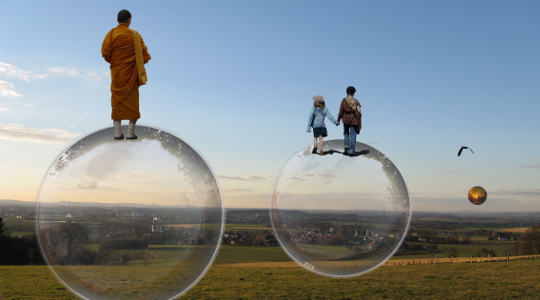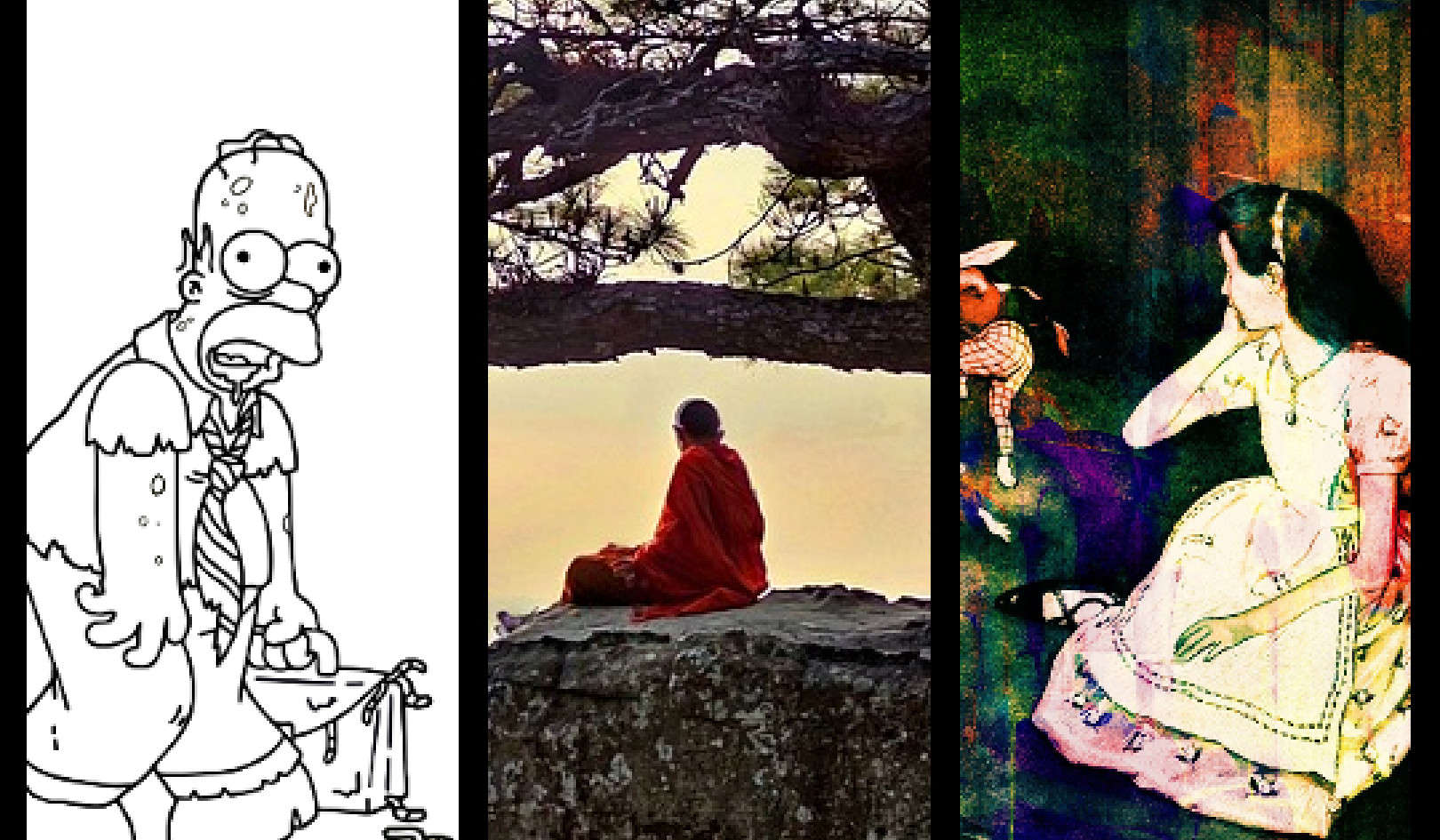
Many people say their lives are so busy that they don’t have time for meditation. Yet every living being must sleep. During sleep time, we don’t schedule meetings or have appointments to keep. The time is ours, and is usually subject to the mindless, random chaos of our undisciplined minds.
We spend nearly one-third of our life sleeping and dreaming. That means that if we live to be ninety, we would have spent thirty years of our life asleep. Can you imagine what it would mean if you were able to understand what is going on during those lost years of your life and to tap that mental power and creativity as a source of spiritual awakening?
Cultivating Wakefulness Within the Dream State
In many of the great wisdom traditions of the world, there are traditions of “dream yoga” meditations that cultivate a sense of lucid wakefulness within the dream state. The profound practices of dream yoga blend the lucid clarity of mindful presence with the boundless creativity of the mind. And they combine elements of creative, reflective, and receptive meditation practices.
Before you go to sleep, hold the clear intention to wake up and be conscious within your dreams. In some Native American traditions, dreamers are advised to remember to look at their hands within a dream, or to raise their hands to the sky in a prayer for rain to bless the earth. Holding a simple intent like this is a good place to begin a dream yoga practice.
Dreams Have Much To Teach Us About Our Waking Life
Dreams have much to teach us about how we “construct” our experiences and sense of identity or self in our waking life. During mindless daily life, we seldom look deeply enough into our perceptions, conceptions, and projections to recognize that our selective attention, biases, preconceptions, and assumptions are actually weaving together to construct our experience.
Properly understood, our ordinary life is seen to be a “waking dream” subject to many of the same conditions of our “sleeping dreams.” Learning to wake up within our dreams, and see and understand deeply and clearly what is going on, can be a profound path of awakening. As Thoreau said, “Our truest life is when we are in our dreams awake.”
Ask yourself, “How do I know what reality is? In my dream last night, I believed it was reality, I felt it, I experienced it, I was moved by it. Then I woke up and discarded these beliefs. How do I distinguish the real from the unreal? Where is last night’s dream now? Where is yesterday’s experience?”
In a similar way, you can reflect upon the waking state as a dream. If you see that nighttime dreams and day time illusions are the same, this can reduce compulsiveness and suffering.
Experiencing Life as a "Relatively True" Dream
As you begin to understand the relativity of your waking life and to experience it more as a dream that is “relatively” true, you will become more receptive to new possibilities and interpretations. Dreams are partial realities, ultimately unreal, illusory.
You can see that your situation may not be quite as serious as you thought. This may shift your sense of self, improve your relationships, and help you to live with greater freedom, compassion, and creativity. There are different ways to go from the unquestioned delusions of ordinary life to a state of spiritual maturity, but learning to regard existence as being dreamlike is one of the most enjoyable and interesting paths.
For most of our lives we have viewed the world as real, solid, and concrete. Learning to see it in a whole different light can be very enlightening. Everything becomes easier. This helps us to lighten up, to be kinder, to hold both the good and the bad more lightly as fleeting, insubstantial, dreamlike experiences.
We begin to sense what infinity may be — infinite time, infinite space, infinite consciousness, infinite possibilities. As you learn to look, listen, and reflect more deeply, you penetrate and deconstruct the layers of illusion and begin to behold reality in its true mystery and magnificence. Approaching life in this way, everyday experience becomes a source of endless joy and delight.
Dream Yoga Practice
Dream yoga practice begins with the understanding that the more present and awake you are in your life, the more present and awake you can become in your sleeping dreams. If in your waking life you allow your mind to be undisciplined, impulsive, driven by mindless habit, what do you expect to find in your dreams?
As you develop greater mindfulness and self-discipline, and learn to focus and understand your mind, it will be more likely that in your dreams you will be better able to harness the power of your mind to gain deeper insight into the nature of reality.
Four Foundations of Dream Yoga Meditation
There are four foundations of dream yoga meditation that are practiced while you are awake.
The first is to regard your waking perceptions — what you see, hear, smell, taste, and touch — as a dream. It’s as if you say to yourself, “Isn’t this an interesting dream experience!” and really believe it to be so. This sets up an inclination in the mind that can be activated in your dreams to regard ordinary and dream experiences as ephemeral, illusory, insubstantial projections and constructions of the mind. Recognizing this within a dream will awaken a strong experience of lucidity and presence. So the first foundation is to regard waking life as a dream.
The second foundation is to begin to reduce the reactivity of your mind—your tendency toward attraction and repulsion while you are awake. When you notice your mind is drawn toward a pleasant sound, smell, taste, touch, or sight, remind yourself that the object, your reaction to the object, and your very sense of self are all a dream, a construction of the mind. Beginning to demagnetize your compulsiveness and reactivity in waking life will free you to be more awake, open, and creative in your dreams.
The third foundation for dream yoga practice takes place just before you go to sleep. It has two phases. First, review the day by allowing memories and images of the day to arise in your mind. As they do, regard all of these memories as being like a dream. Then, on the basis of this recognition, shift to phase two and generate a strong determination to vividly and clearly recognize your sleeping dreams as also being dreams. As you go to sleep, hold this strong intention to be mindful of your dreaming, and pray for help and inspiration to remember your intention.
The fourth foundation is to rejoice and be grateful upon waking up if you were actually able to have a clear and lucid dream. Let your successes deepen your confidence and rejoice. Let your failures to be mindful of your dreams help you to strengthen your determination to recognize your dreams, and strengthen your prayers that you might awaken within your dreams.
It can also be helpful before you go to sleep to do some meditation to clear the mind and purify some of the negativity or emotional turbulence that has accumulated during the day. Practice deep relaxation and the loving-kindness meditation, or the radiant being meditation, or any other practices that are helpful to calm and clear the mind.
Releasing the Mind from Its Limitations
The actual practice of dream yoga is to recognize and transform the ordinary habits of the mind and to release the mind from its limitations into a wholesome and bound less display of our innate creativity and compassion. One technique is to practice multiplying things in a dream. If in a dream you see a flower or a tree, mentally multiply it so that there are a dozen, or a thousand, or a limitless number of flowers or trees filling the vastness of space.
The classic texts outline eleven categories of ordinary mental experience that are transformed through the practice of dream yoga. These involve the multiplication of objects; the “morphing” of the size of an object making it bigger or smaller; changing the quantity or quality of the objects
in the dream; modulating the experience of movement by speeding things up and slowing things down within the dream; transforming things into other things; emanating rays of light and other things from one’s body; traveling from place to place; and generating a boundless array of extraordinary experiences. All of these are ways of stretching the mind to realize its infinite creative potential which is normally eclipsed by habit. As the mind becomes more open, flexible, and supple, we discover a new freedom of mind and come to better understand how we construct the illusion of our ordinary experiences.
A Word Of Caution
A word of caution: Remember that developing the foundations for dream yoga in your waking life can protect you from getting too fascinated and attached to the experiences you create in your dreams. This is especially important as some people who practice less grounded traditions of lucid dreaming run the risk of being seduced by their own creations, and actually reinforcing some of the negative habits of the mind. As with all meditation practices, beginning dream yoga practice with the Taking Refuge meditation will help ensure that the meditation will be most beneficial and effective.
Dream yoga is a very profound practice that is also regarded as a training in staying conscious at the time of death and in making the transition from this life onto the path of awakening to your True Nature. It is said that to awaken to your True Nature at death, you must first learn to awaken fully within deep, dreamless sleep.
To awaken within dreamless sleep, you must learn to awaken within your dreams. And to awaken with your dreams, you must learn to be mindfully present and awake to the illusory display of your daily life. Taken to heart, this advice helps us recognize that the practice of mindfulness itself opens the way for us to be present in every experience of our life, and perhaps beyond.
©1999, 2015 by Joel Levey & Michelle Levey. All rights reserved.
Reprinted with permission of the publisher, Conari Press,
an imprint of Red Wheel/Weiser, LLC. www.redwheelweiser.com.
Article Source
 Mindfulness, Meditation, and Mind Fitness
Mindfulness, Meditation, and Mind Fitness
by Joel Levey and Michelle Levey.
Click here for more info and/or to order this book.
About the Authors
 Dr. Joel and Michelle Levey were among the very first to bring mindfulness and mind-fitness teachings to mainstream organizations beginning in the 1970s. They have taught tens of thousands of people in hundreds of leading corporations, medical centers, universities, sports, government, and military arenas, including Google, NASA, World Bank, Intel, M.I.T., Stanford, and World Business Academy. They are the founders of Wisdom at Work.
Dr. Joel and Michelle Levey were among the very first to bring mindfulness and mind-fitness teachings to mainstream organizations beginning in the 1970s. They have taught tens of thousands of people in hundreds of leading corporations, medical centers, universities, sports, government, and military arenas, including Google, NASA, World Bank, Intel, M.I.T., Stanford, and World Business Academy. They are the founders of Wisdom at Work.
Watch a video: Experiencing Mind-Fitness (with Joel & Michelle Levey)

























